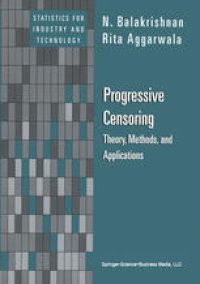
Ebook: Progressive Censoring: Theory, Methods, and Applications
- Genre: Mathematics // Mathematicsematical Statistics
- Tags: Statistical Theory and Methods, Statistics for Engineering Physics Computer Science Chemistry and Earth Sciences
- Series: Statistics for Industry and Technology
- Year: 2000
- Publisher: Birkhäuser Basel
- Edition: 1
- Language: English
- pdf
Censored sampling arises in a life-testing experiment whenever the experimenter does not observe (either intentionally or unintentionally) the failure times of all units placed on a life-test. Inference based on censored sampling has been studied during the past 50 years by numerous authors for a wide range of lifetime distributions such as normal, exponential, gamma, Rayleigh, Weibull, extreme value, log-normal, inverse Gaussian, logistic, Laplace, and Pareto. Naturally, there are many different forms of censoring that have been discussed in the literature. In this book, we consider a versatile scheme of censoring called progressive Type-II censoring. Under this scheme of censoring, from a total of n units placed on a life-test, only m are completely observed until failure. At the time of the first failure, Rl of the n - 1 surviving units are randomly withdrawn (or censored) from the life-testing experiment. At the time of the next failure, R2 of the n - 2 -Rl surviving units are censored, and so on. Finally, at the time of the m-th failure, all the remaining Rm = n - m -Rl - . . . - Rm-l surviving units are censored. Note that censoring takes place here progressively in m stages. Clearly, this scheme includes as special cases the complete sample situation (when m = nand Rl = . . . = Rm = 0) and the conventional Type-II right censoring situation (when Rl = . . . = Rm-l = 0 and Rm = n - m).
This new book offers a thorough guide to the theory and methods of progressive censoring for practitioners and professionals in applied statistics, quality control, life testing and reliability testing. In many industrial experiments involving lifetimes of machines or units, experiments have to be terminated early due to a variety of circumstances. Samples that arise from such experiments are called censored samples, and a new, efficient alternative method is referred to as "progressive censoring" (where the removal of live units at time of failure is employed).
Progressive Censoring first introduces progressive sampling foundations, then discusses various properties of progressive samples. It also describes how to make exact or approximate inferences for the different statistical models with samples based on progressive censoring schemes. With many concrete examples, the book points out the greater efficiency gained by using this scheme instead of classical right-censoring methods.
This new book offers a thorough guide to the theory and methods of progressive censoring for practitioners and professionals in applied statistics, quality control, life testing and reliability testing. In many industrial experiments involving lifetimes of machines or units, experiments have to be terminated early due to a variety of circumstances. Samples that arise from such experiments are called censored samples, and a new, efficient alternative method is referred to as "progressive censoring" (where the removal of live units at time of failure is employed).
Progressive Censoring first introduces progressive sampling foundations, then discusses various properties of progressive samples. It also describes how to make exact or approximate inferences for the different statistical models with samples based on progressive censoring schemes. With many concrete examples, the book points out the greater efficiency gained by using this scheme instead of classical right-censoring methods.
Content:
Front Matter....Pages i-xv
Introduction....Pages 1-10
Mathematical Properties of Progressively Type-II Right Censored Order Statistics....Pages 11-29
Simulational Algorithms....Pages 31-40
Recursive Computation and Algorithms....Pages 41-65
Alternative Computational Methods....Pages 67-83
Linear Inference....Pages 85-115
Likelihood Inference: Type-I and Type-II Censoring....Pages 117-138
Linear Prediction....Pages 139-165
Conditional Inference....Pages 167-181
Optimal Censoring Schemes....Pages 183-214
Acceptance Sampling Plans....Pages 215-222
Back Matter....Pages 223-248
This new book offers a thorough guide to the theory and methods of progressive censoring for practitioners and professionals in applied statistics, quality control, life testing and reliability testing. In many industrial experiments involving lifetimes of machines or units, experiments have to be terminated early due to a variety of circumstances. Samples that arise from such experiments are called censored samples, and a new, efficient alternative method is referred to as "progressive censoring" (where the removal of live units at time of failure is employed).
Progressive Censoring first introduces progressive sampling foundations, then discusses various properties of progressive samples. It also describes how to make exact or approximate inferences for the different statistical models with samples based on progressive censoring schemes. With many concrete examples, the book points out the greater efficiency gained by using this scheme instead of classical right-censoring methods.
Content:
Front Matter....Pages i-xv
Introduction....Pages 1-10
Mathematical Properties of Progressively Type-II Right Censored Order Statistics....Pages 11-29
Simulational Algorithms....Pages 31-40
Recursive Computation and Algorithms....Pages 41-65
Alternative Computational Methods....Pages 67-83
Linear Inference....Pages 85-115
Likelihood Inference: Type-I and Type-II Censoring....Pages 117-138
Linear Prediction....Pages 139-165
Conditional Inference....Pages 167-181
Optimal Censoring Schemes....Pages 183-214
Acceptance Sampling Plans....Pages 215-222
Back Matter....Pages 223-248
....